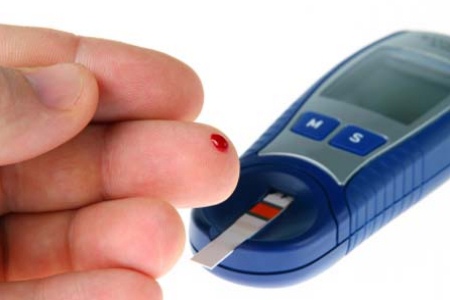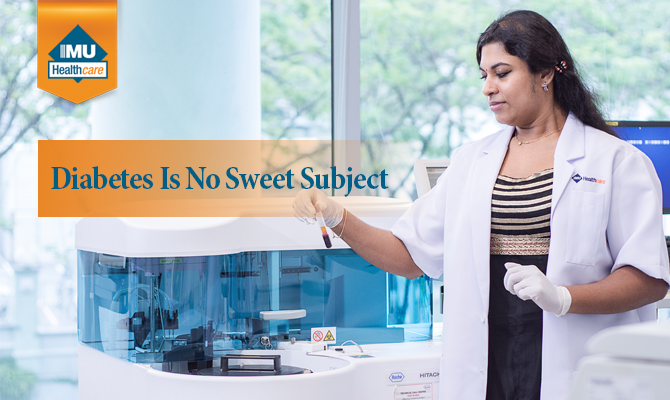The main things you need to know about this silent killer. The word diabetes has been used so commonly that sometimes people may forget the severity of this chronic, long-term condition. When you hear someone refuse a piece of chocolate and say, “Oh, I can’t; I’m diabetic,” you might hazard a guess that the response is a shrug and no further thought. The reality is that a person suffering from diabetes can run the risk of complications such as coronary heart disease, kidney damage or even stroke. We’ll explain why.
Diabetes can be explained simply in these simple steps. When we consume food, most of the food is converted into a sugar (there are two main categories of sugars: monosaccharides are simple sugars, while disaccharides consist of molecules whose form is that of two monosaccharide molecules joined together); that simple sugar is glucose. Glucose is what the body needs and uses for energy; it is the main fuel source for the body, like how a car needs petrol to run on. Without glucose, the body finds it hard to function. Now that we’ve established how important glucose is, let’s establish how important it is to keep it in check, in a manner of speaking.
The Gatekeeper For glucose to give us energy, it needs to be converted from the food we’ve consumed, after which it is able to circulate freely in our bloodstream. Once it’s in our bloodstream, it needs to pass into our cells. All the cells in our body require glucose. So does the brain. However, in order for glucose to find its way into our cells, it needs a partner: insulin.
Without insulin, glucose just keeps going around and around our body, travelling along in our bloodstream, like a happy child on a carousel.
And this is where the problem begins. When glucose is unable to enter our cells from our bloodstream because we do not have enough insulin, we simply don’t have enough fuel to burn.  More to the point, an excess of glucose is called hyperglycaemia. The body then attempts to get rid of the excess glucose by excreting it into the urine. When this happens, a person can experience dehydration from increased urine output. Simultaneously, the body’s cells are starved of the glucose they need to give us energy. This is just the beginning of symptoms that may help you identify or address any concern that you may be diabetic. What To Look For The symptoms experienced by a person with diabetes, or some of the early signs that you may be on the on-set of diabetes include weight loss, excessive thirst, excessive urination, fatigue, nausea, irritability, yeast infections, blurry vision, skin wounds or infections that are slow to heal, and numbness or tingling in the feet. But we must bear in mind that there are several types of diabetes, including Type 1, Type 2 and gestational. The key point to remember is that a lack of insulin is the key trigger. Insulin is a hormone and it is produced in the pancreas. The pancreas, a large gland, sits just behind the stomach. Under normal circumstances, insulin production in the body will rise and fall according to what the body needs. Beta cells (in the pancreas) produce the correct amounts of insulin automatically, to help move glucose into our cells. Diabetes occurs when a person’s body experiences a problem with the production of insulin, or with the body’s ability to use the insulin.
More to the point, an excess of glucose is called hyperglycaemia. The body then attempts to get rid of the excess glucose by excreting it into the urine. When this happens, a person can experience dehydration from increased urine output. Simultaneously, the body’s cells are starved of the glucose they need to give us energy. This is just the beginning of symptoms that may help you identify or address any concern that you may be diabetic. What To Look For The symptoms experienced by a person with diabetes, or some of the early signs that you may be on the on-set of diabetes include weight loss, excessive thirst, excessive urination, fatigue, nausea, irritability, yeast infections, blurry vision, skin wounds or infections that are slow to heal, and numbness or tingling in the feet. But we must bear in mind that there are several types of diabetes, including Type 1, Type 2 and gestational. The key point to remember is that a lack of insulin is the key trigger. Insulin is a hormone and it is produced in the pancreas. The pancreas, a large gland, sits just behind the stomach. Under normal circumstances, insulin production in the body will rise and fall according to what the body needs. Beta cells (in the pancreas) produce the correct amounts of insulin automatically, to help move glucose into our cells. Diabetes occurs when a person’s body experiences a problem with the production of insulin, or with the body’s ability to use the insulin.
Type 1 diabetes is sometimes referred to as juvenile onset diabetes and is thought to occur as the result of an autoimmune disease. In Type 2 diabetes the pancreas may still produce insulin, just not enough to fulfil the body’s requirements. Gestational diabetes, while uncommon, is a form of diabetes that can occur during pregnancy.
 The best way to know is, of course, to get a proper medical diagnosis. The most common method of diagnosis is via a fasting glucose sample. If this number is abnormal, the doctor will arrange to have further tests, like HbA1c, to be done to confirm the diagnosis. The HbA1c test is an oral glucose test, or two fasting or random blood tests using a venous sample. A venous sample is a sample of blood is taken from a certain vein and checked for specific substances released by nearby organs and tissues. Control, Not Cure Unfortunately, once detected, diagnosed and confirmed, diabetes cannot be cured, but it can be managed. Most treatments aim to control the blood glucose level, and a three-way approach involving diet, exercise (lifestyle factors) and medication is usually recommended. It is important for any person with diabetes to be treated and monitored by a doctor in order to control the condition. While many may find their own General Practitioner to be sufficient when it comes to seeking advice and assisting in the management of the condition, there exists a wider number of diabetes management medical professionals such as an endocrinologist (a diabetes specialist), a diabetes nurse educator, a dietitian, podiatrist, and others. Simple Adjustments There are lifestyle considerations to help you with this metabolic condition that is diabetes. Individuals with diabetes can enjoy a range of healthy and delicious food, as long as particular attention is given to the amount of carbohydrates eaten. A dietitian would be able to help an individual with diabetes to map out a meal plan which can guide the individual on how much and what kinds of food can be eaten at meals and snack times. A meal plan like this is designed to fit in with one’s schedule and eating habits.
The best way to know is, of course, to get a proper medical diagnosis. The most common method of diagnosis is via a fasting glucose sample. If this number is abnormal, the doctor will arrange to have further tests, like HbA1c, to be done to confirm the diagnosis. The HbA1c test is an oral glucose test, or two fasting or random blood tests using a venous sample. A venous sample is a sample of blood is taken from a certain vein and checked for specific substances released by nearby organs and tissues. Control, Not Cure Unfortunately, once detected, diagnosed and confirmed, diabetes cannot be cured, but it can be managed. Most treatments aim to control the blood glucose level, and a three-way approach involving diet, exercise (lifestyle factors) and medication is usually recommended. It is important for any person with diabetes to be treated and monitored by a doctor in order to control the condition. While many may find their own General Practitioner to be sufficient when it comes to seeking advice and assisting in the management of the condition, there exists a wider number of diabetes management medical professionals such as an endocrinologist (a diabetes specialist), a diabetes nurse educator, a dietitian, podiatrist, and others. Simple Adjustments There are lifestyle considerations to help you with this metabolic condition that is diabetes. Individuals with diabetes can enjoy a range of healthy and delicious food, as long as particular attention is given to the amount of carbohydrates eaten. A dietitian would be able to help an individual with diabetes to map out a meal plan which can guide the individual on how much and what kinds of food can be eaten at meals and snack times. A meal plan like this is designed to fit in with one’s schedule and eating habits.  While regular exercise has numerous benefits for mental health, bone health and overall mobility and muscle health, it is also good for maintaining that crucial blood glucose level so necessary to prevent or manage diabetes. However, some health experts also caution that too much exercise can cause blood glucose levels to drop to a worrying level. Too high a blood glucose level is not good, but too low is not healthy either. Self-monitoring is another important aspect of daily care. Self-monitoring includes checking your blood glucose, blood pressure and body weight, since diabetes management is meant to help prevent complications that may arise from the condition.
While regular exercise has numerous benefits for mental health, bone health and overall mobility and muscle health, it is also good for maintaining that crucial blood glucose level so necessary to prevent or manage diabetes. However, some health experts also caution that too much exercise can cause blood glucose levels to drop to a worrying level. Too high a blood glucose level is not good, but too low is not healthy either. Self-monitoring is another important aspect of daily care. Self-monitoring includes checking your blood glucose, blood pressure and body weight, since diabetes management is meant to help prevent complications that may arise from the condition.  There are other lifestyle factors such as stress and smoking which can affect blood glucose levels. Smoking in particular has been linked to people developing many diabetic complications. This is just one of the reasons doctors urge people with diabetes to abstain from, or stop, smoking. While there are challenges to living with diabetes, the silver lining is knowing that research on this disease continues, so that new and more effective treatments and management systems for this condition are constantly being developed. Such developments include the possibility of devices that can measure blood glucose levels through the skin rather than testing for it via a finger prick of blood. There are also controversial treatments such as the transplantation of insulin-producing animal cells into humans. Many times, being diagnosed a diabetic can send a person into a tailspin, with the immediate reaction being, “That’s it, no more sugar for me.” However, with proper management, and a team of dedicated specialists to which you can turn to for advice, you will soon learn that diabetes need not be as limiting as you might have thought. This article is brought to you by IMU Healthcare. Related articles: Taking Special Care of that Sweet Tooth Diabetes from a Chiropractic Perspective The Yin and Yang of Diabetes Treatment
There are other lifestyle factors such as stress and smoking which can affect blood glucose levels. Smoking in particular has been linked to people developing many diabetic complications. This is just one of the reasons doctors urge people with diabetes to abstain from, or stop, smoking. While there are challenges to living with diabetes, the silver lining is knowing that research on this disease continues, so that new and more effective treatments and management systems for this condition are constantly being developed. Such developments include the possibility of devices that can measure blood glucose levels through the skin rather than testing for it via a finger prick of blood. There are also controversial treatments such as the transplantation of insulin-producing animal cells into humans. Many times, being diagnosed a diabetic can send a person into a tailspin, with the immediate reaction being, “That’s it, no more sugar for me.” However, with proper management, and a team of dedicated specialists to which you can turn to for advice, you will soon learn that diabetes need not be as limiting as you might have thought. This article is brought to you by IMU Healthcare. Related articles: Taking Special Care of that Sweet Tooth Diabetes from a Chiropractic Perspective The Yin and Yang of Diabetes Treatment









